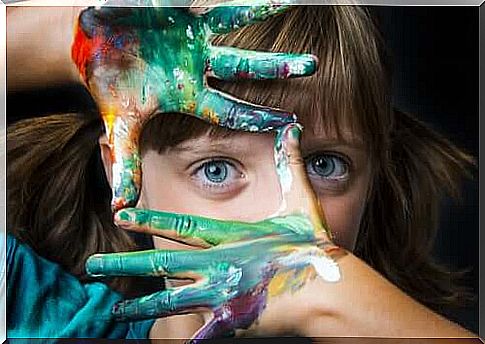Creativity In Children: Points To Develop It

Most parents want their children to be obedient, attentive, intelligent, and socially pleasing. They want the best for them and to get it they work hours and hours facing any unexpected. Among the qualities they would like to be able to choose, if they had a magic wand, there is also creativity. But how to stimulate creativity in children? How can you reproduce those magical moments in which novelty comes to life from pure ingenuity?
Well, there are several strategies. All logical, consistent and with proven effectiveness. They stand out because they require parents or other reference figures who are active and involved in their application. Anything but: “Can’t you sit still?” or “I don’t have time for your stories now.”
To develop creativity in children, an effort must be made to overcome the inertia promoted by an educational system that tends towards uniformity (Ferrándiz, 2011).

The organization of time, a challenge for creativity
English, swimming, maths, football, chess, writing workshops… The offer of activities for children is truly vast. We could say that today’s children are privileged, as they no longer need to live in a big city to have a program of activities suited to their interests or those of their parents.
The threat of an overly competitive adult world causes many parents to make financial efforts so that their children can access additional training.
However, this also comes with a high price. Children don’t get bored, they don’t need to invent games or transform an uninspiring environment into a fun one. Because it is true that creativity begins with jokes, games and managing one’s time: a difficult goal to achieve if we tell the little ones what to do every moment.
The first strategy to enhance creativity in children is therefore to offer them the time and space they need to make choices out of the pressure of external demands. Divergent thinking is meaningless without the achievement of autonomy: creativity is enhanced when it is used to solve real problems.
Stimulating creativity in children: the difficulty of the challenges
Yes, children can also develop their creativity through guided activities. This phenomenon occurs, in particular, when there is intelligent regulation of challenges. In this regard, we will talk about two modes of challenges.
The first group consists of the challenges that the child, with a little effort, can face alone. On this occasion, adults can support him with encouraging phrases, facing a parallel challenge to avoid the temptation to help him. Achieving the desired results will strengthen his self-esteem.
The second group consists of some challenges for which the child needs a little help : a calculation that he is not yet able to perform, a word he does not know the meaning of, a place too far away to get there alone.
In these cases, the temptation to dodge the challenge translates into taking control. We calculate, but they solve the problem; we act as a dictionary, they answer questions; we accompany them, but they guide us along the path they have already learned.

Technology and social situations
“How good, how beautiful, how awake!”. Many parents like their children to publicly display newly acquired skills. Often, however, the child has no desire to test his skills in an environment where he feels judged and insecure. This can make him wrong, make him feel anxious, and inhibit him.
On the other hand, social environments are an ideal opportunity for the development of creativity. Natural, unexpected changes occur in them to react, think and respond to.
At these and other times, it’s important that technology stays out of reach. That is, the child faces the challenges of the real world, and of the people around him, not through a game on the screen.









